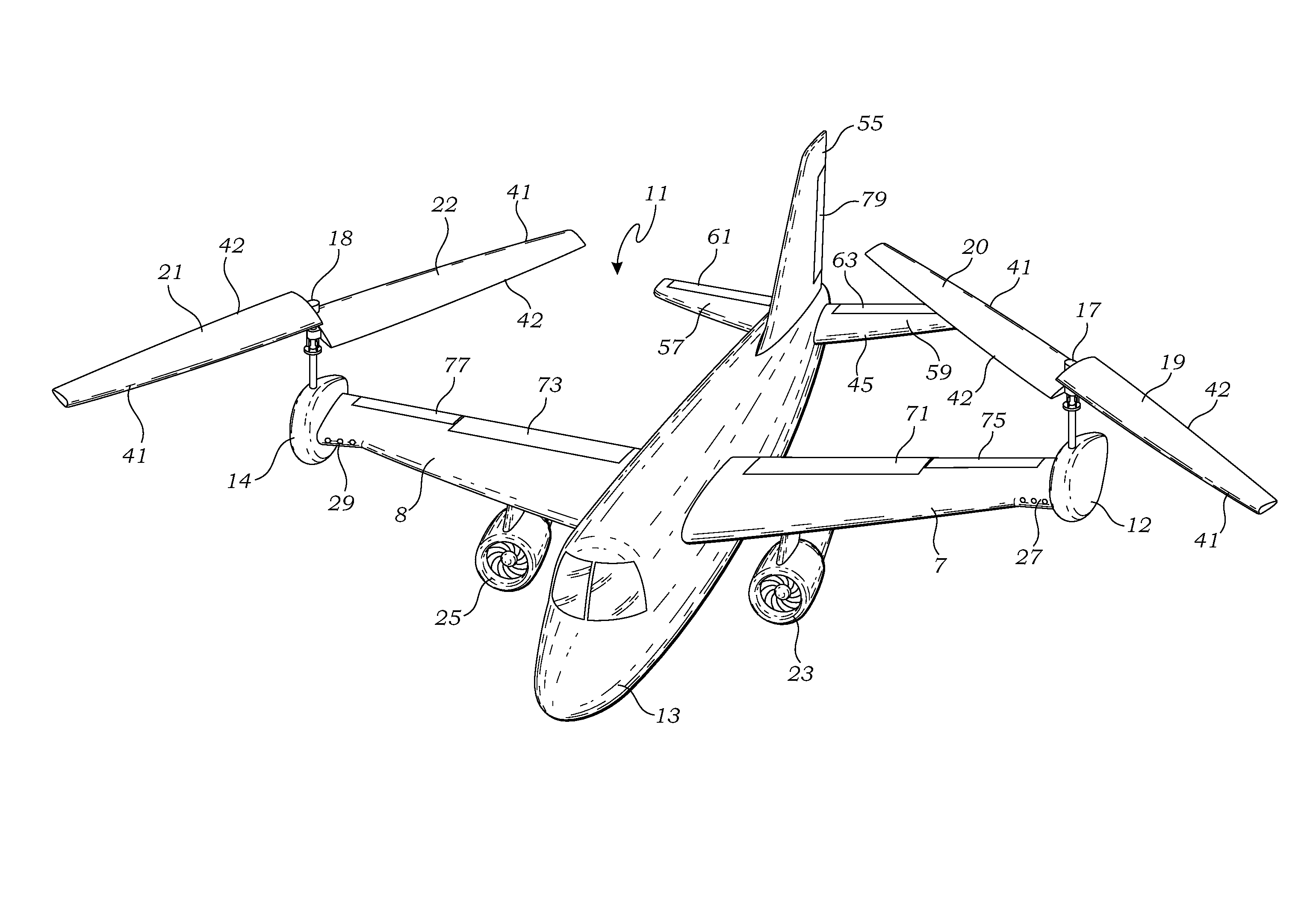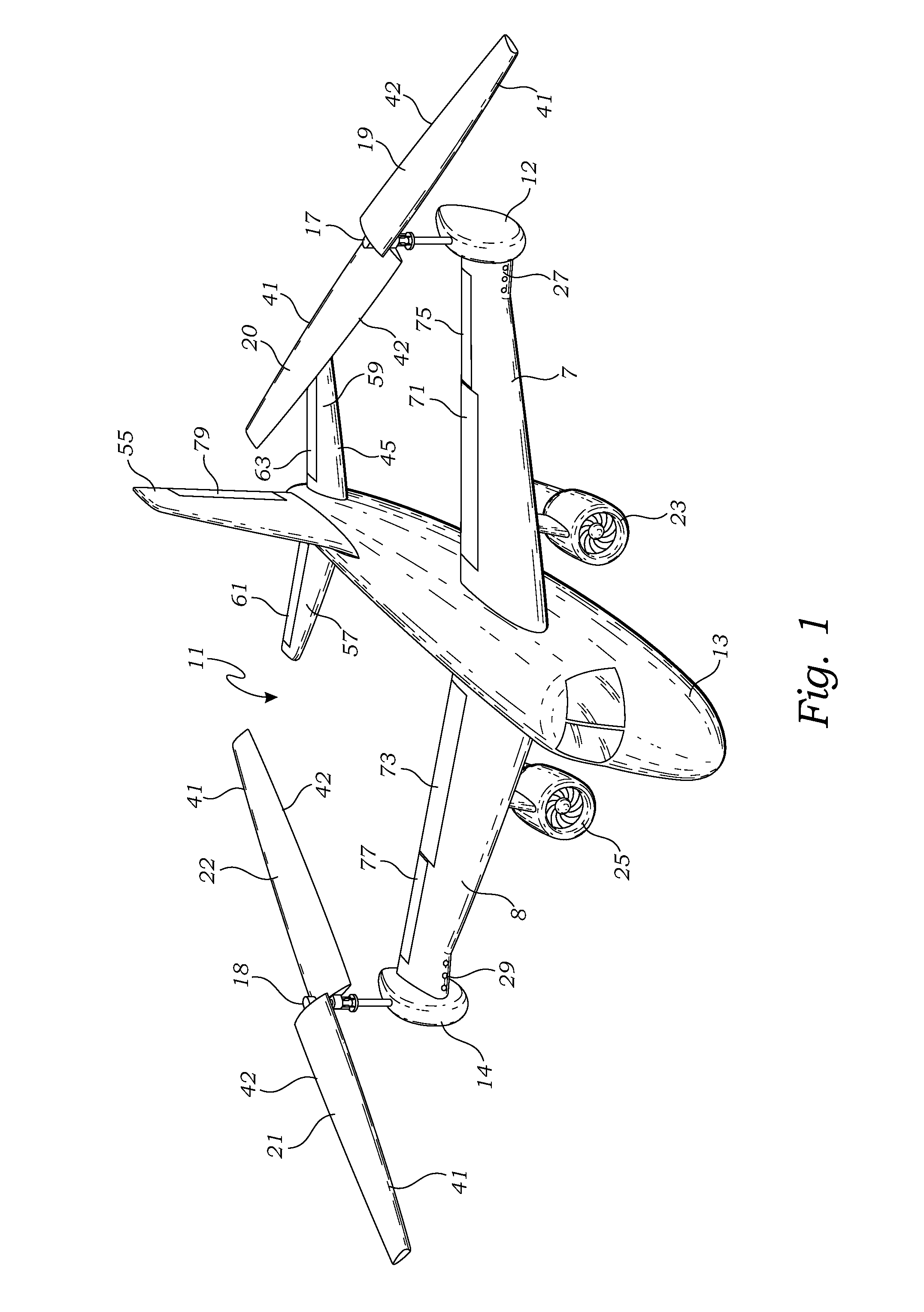Rotary wing aircraft such as helicopters and gyroplanes cannot fly forward at high speeds like
fixed wing aircraft.
Due to the phenomenon known as the “dissymmetry of lift” caused by the differences in relative air speeds between the advancing blade and the retreating blade, the compressability effect of the advancing blade, the retreating blade stall, and the excessive drag caused by the rotating wings at higher speeds, there is a relatively
low speed limit a helicopter or a gyroplane can not exceed.
However, conventional fixed wing aircraft are not capable of V / STOL and hover.
Demonstrated designs appear to be an unsatisfactory compromise between the two.
These aircraft compromise both hovering efficiency, because of high-disk-loading, and
forward speed.
When the rotors are tilted forward for
forward flight they become inefficient impellers above about 300 miles / hour.
The trail rotor and folding tilt rotor have the potential to overcome the inefficiency of the tilt rotor by having low-disc-loading during hover, and high-fixed-wing-loading during
high speed flight, however, since the rotors have to be tilted forward or aft 90 degrees before the rotors are stopped in a
vertical plane of rotation, these two concepts have an even more complex and lengthy conversion process than the tilt rotor.
These aircraft have hover efficiencies approaching a helicopter, yet require the additional weight of a fixed wing since the stopped rotor does not provide any lift.
A major challenge in horizontally stopped / lifting rotor aircraft is related to, besides the stopping of the rotor itself, how to deal with the reverse flow problems associated with any blade in the retreating region.
If a retreating blade has a typical airfoil shape with a tapered
trailing edge and a rounded
leading edge, after it is stopped, reverse flow from the tapered edge to the rounded edge can cause flow separation and aerodynamic problems.
The single-bladed rotor creates balance-of-force and oscillation problems in rotary flights due to the single-bladed rotors.
It also requires a complex mechanism to rotate the blade at the trailing position by 90 degrees about its
pitch axis while keeping the outboard blade substantially horizontal.
Since two of the four main rotor airfoils are essentially flying backwards in the fixed wing position (relative to their
rotary wing airfoil position), a complicated air circulation
control system is required for each airfoil to achieve lift in both the rotary and fixed wing operation.
Complexity and number of the mechanisms associated with main rotor airfoil circulation control, and questionable reliability of successfully transitioning between
rotary wing and fixed wing flight, and
vise versa, caused the program to be abandoned.
This invention has the
disadvantage of structural and control difficulties associated with the flipping of blades.
During the flipping of blades, the blades have to go through a vertical position where the cross section area exposed to the airstream is maximized, causing a tremendous
aerodynamic drag.
Although the spike of drag only lasts for a short period of time, it is enough to cause structural and
yaw control stability issues.
This invention has a
disadvantage of high drag and low lift efficiency.
In order for the retreating blade to avoid flow separation problems due to reverse flow after stopping, the blade airfoil cannot adopt the most efficient shape of a typical airfoil, and instead has to be compromised to adopt the less efficient shape with a rounded
trailing edge identical to the
leading edge, which leads to high drag and low lift efficiency in both rotary wing mode and fixed wing mode.
In addition, the collective
pitch control is further complicated due to the fact that the retreating blade's leading and trailing edges switch positions after stopping.
The two straight wings limit the efficiency in high-speed flights due to drag
divergence.
For the same reason as in the CRW, the rotor / wing has to adopt an airfoil cross section with a trailing edge substantially identical to the leading edge, which increases drag in both flight
modes.
This invention has a
disadvantage of low flying efficiency and low lift efficiency.
In helicopter mode, the relatively small and low
aspect ratio stub blades are not efficient in generating lift, therefore requiring high induced power to generate the necessary lift.
For the same reason as in the CRW, the two lifting stub blades has to adopt an airfoil cross section with a trailing edge substantially identical to the leading edge, which increases drag in both flight
modes.
This invention has a disadvantage of complexity, as well as the disadvantages of structural and control difficulties associated with flipping the flaps.
Flipping the flaps creates similar structural and
yaw control difficulties as flipping the blades in U.S. Pat. No. 5,405,104.
However, this process increases the complexity of the motor locator control, and lengthens the duration of the conversion between the rotary wing mode and fixed wing mode.
All helipanes utilizing horizontally stopped / lifting rotor must face the reverse flow problems associated with any blade in the retreating region.
 Login to View More
Login to View More  Login to View More
Login to View More 


